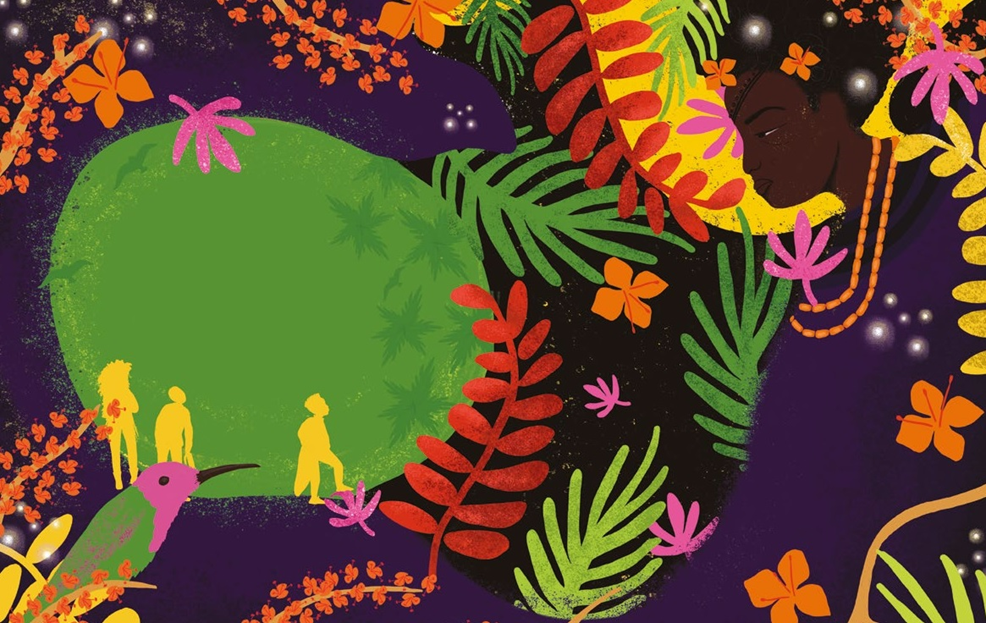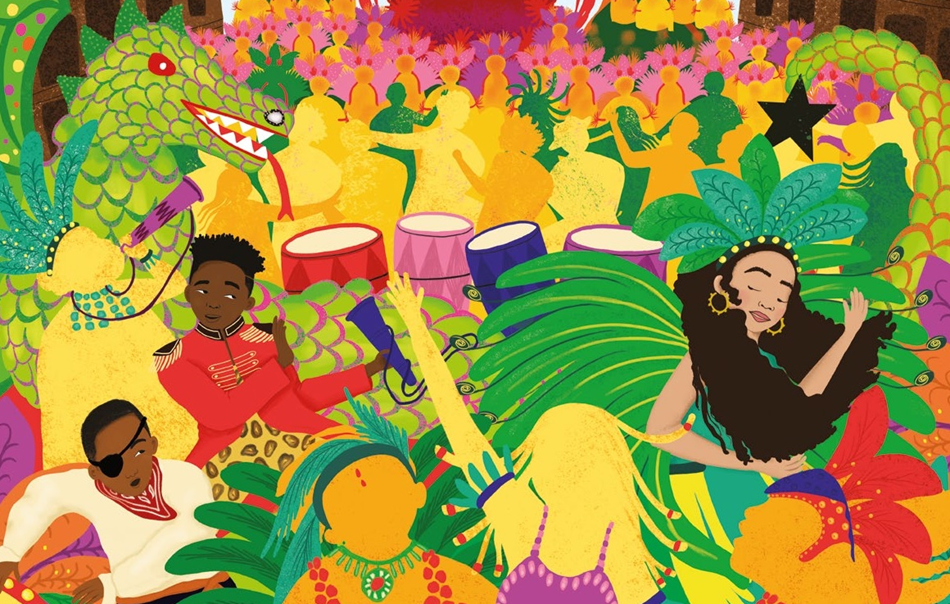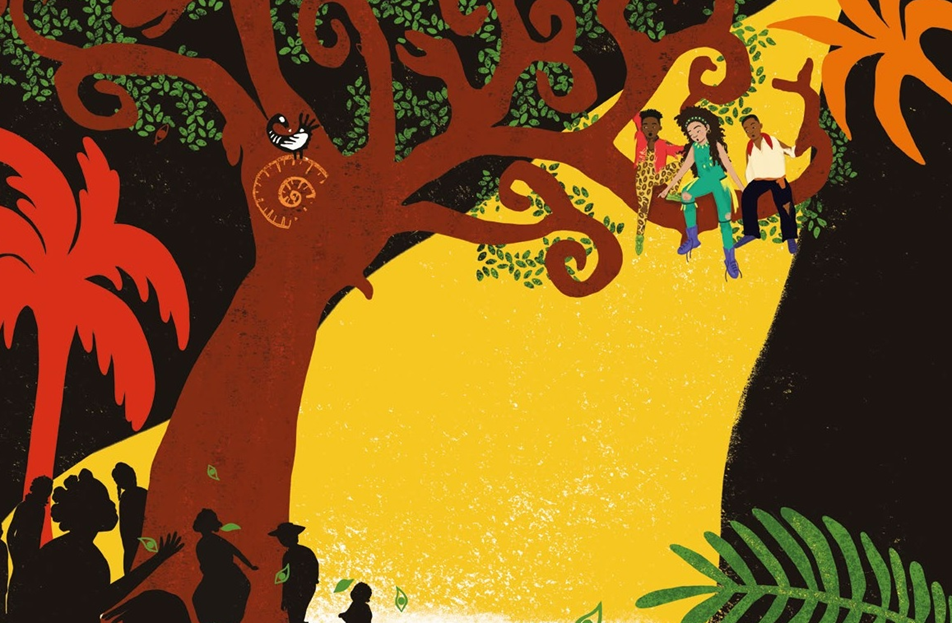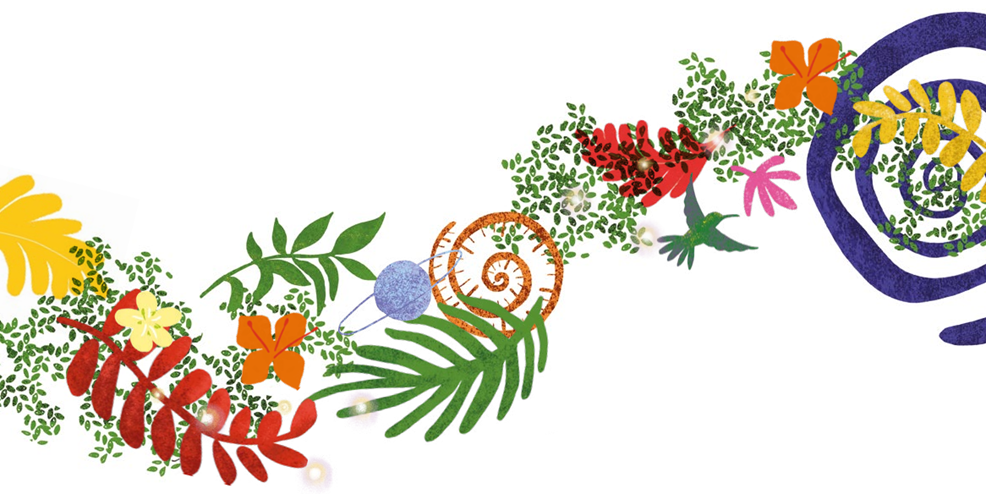Yaba Badoe and Joelle Avelino


About Author
Yaba Badoe is an award-winning documentary filmmaker and author. Yaba was born in Ghana but now lives in London with her husband. Her children's novels A Jigsaw of Fire and Stars, Wolf Light and Lionheart Girl are published by Zephyr. Yaba is a judge for the Jhalak Prize 2023.
Joelle Avelino is a Congolese and Angolan illustrator who grew up in the UK and lives in London. She has a BA in illustration with marketing from the University of Hertfordshire. She has worked on several books including Hey You! by Dapo Adeola.
Interview
Man-Man and the Tree of Memories (Zephyr)
October 2023
Chapter One: Man-Man and the Tree of Memories
Teachers' Notes for Man-Man and the Tree of Memories
In this story about families, ancestral stories and magic, author Yaba Badoe explores cultural traditions of carnivals and dance, while reflecting on how ancestral links to darker memories of enslavement continue to echo through the ages.
Yaba introduces the story and its themes in this video, and gives a short reading from Man-Man and the Tree of Memories (Zephyr Publishing).
Q&A with Yaba Badoe and Joelle Avelino
"Man-man's quest, sumptuously illustrated by Joelle Avelino, allowed me to explore the African roots of carnival at the same time as probing the historical injustice of slavery."
1. Hello Yaba, thank you for joining us on ReadingZone. Can you tell us a little more about yourself, and what inspires you to put pen to paper?
I've spent most of my life working as a producer and director in television. I started out as a general trainee at the BBC and have made films for the BBC, ITV, Channel 4, NGO's in Britain and Africa, as well as documentaries for my production company, Fadoa Films.
For as long as I can remember, I've been fascinated by stories. My grandmother told me Ananse stories as a child. I devoured fairy stories - the Brothers Grimm and Hans Christian Anderson - at prep school; and at 12, I decided that I wanted to tell stories too!
I suspect that I write for young people and adults because there's a child inside me that I'm constantly trying to satisfy: a child hungry for stories in which she's the heroine; a child ravenous for fantastical, magical tales of courage and quest, stories of home and abroad, peopled by folk who look like her and who want her to succeed.
My journey to publication was a long one, yet I persisted because to my mind, putting pen to paper is the most powerful thing a writer can do to help change the world by shifting the balance of stories in it.
2. What is your new book, Man-man and the Tree of Memories, about? How did your character, Man-man, develop?
Man-man and the Tree of Memories seeded in my imagination when I was asked to consider writing a story about carnival. The story germinated, creating Man-man, a dancer determined to help his mother recover from an illness that's plagued generations of women her family.
I once met a boy in the parish of St Mary, Jamaica, called Man-man. I asked my friend Sonja Harris, who I was staying with at the time, why he'd been given his name. She shrugged, then suggested that perhaps it was because the boy had 'mannish' ways. He took on responsibilities beyond his age. The name stayed with me until I was able to use it to tell the story of a boy, so devoted to his mother, that he's prepared to do everything in his power to make her better.
3. How important is carnival time and particularly the Notting Hill Carnival - which features in the story - to you? What inspired the character of the Queen of Revels, who plays such a big role in this story?
As a Londoner who relishes the cultural diversity my city has to offer, Notting Hill Carnival has a special place in my heart. A long time ago, a friend's mother, Rosamond Henriques, who lived in Notting Hill, used to have a party every year to celebrate carnival. We'd lunch heartily and then watch festivities from her window. The joy of carnivals past and present has stayed with me. It reminds me that for as long as there have been people on the planet, no matter the difficulties we've faced, we've celebrated life through music, dance, and art. This is where the Queen of Revels comes in.
As for the Queen of Revels, I wanted to create a mythical figure who's been called various names at different times in disparate cultures but who is present whenever we celebrate. I wanted to portray a fantastical creature in tune with Man-man's fears and foibles who is able to transport him through time to help him understand his mother's malady. Man-man's quest, sumptuously illustrated by Joelle Avelino, allowed me to explore the African roots of carnival at the same time as probing the historical injustice of slavery.

The Queen of Revels: "I wanted to create a mythical figure who's been called various names at different times in disparate cultures but who is present whenever we celebrate."
4. The carnival has such a central role in this story; did you need to research into carnivals - and were there any surprises?
I was fortunate that the George Padmore Institute opened their archive of carnival paraphernalia to me. A friend, Jane Ripley, a designer of carnival floats, helped me understand their structure and design. A former student of mine while I was teaching at the University of the West Indies, Yinka Williams, a lover of carnival, shared her photos and videos of bands in the Caribbean and Britain. She also talked to me at length and read a draft of the manuscript to correct my patois. So yes! I did research carnivals, Notting Hill in particular.
Perhaps the most important aspect of my research was on my travels as a film maker. While at a film festival in Brazil, I had the privilege of watching preparations for the Rio carnival at a samba school. The dancing was superb! I've also filmed religious processions and masquerades at Ouidah, Benin: a procession with singing and dancing in memory of Africans transported as slaves and a masquerade to celebrate the return of ancestors.
Ouidah is where I first heard of the Tree of Oblivion, which I've renamed the Tree of Memories. Wherever I've travelled in Africa and its diaspora, I'm always struck by connections in music, song and dance that resonate with people of African descent and remind us of where we come from.
"Children have a fierce, unflinching sense of justice and are willing to be challenged. Especially since so many black children already have a sense that the racism we face today is somehow linked to slavery."
5. Why did you decide to literally root the story in memories of the time of enslavement, through the Memory Tree?
To begin with I was very ambivalent about tackling the theme of slavery in Man-man and the Tree of Memories. Surely, I argued with myself, this would be too unsettling and difficult for middle grade readers. Best leave it alone, even though everyone knows that the African diaspora was created by the slave trade.
It was only after a conversation with the late Marcus Sedgwick at a writing retreat at his home in France that I decided to go for it. He reassured me that children, for the most part, have a fierce, unflinching sense of justice and are willing to be challenged. Especially since so many black children already have a sense that the racism we face today is somehow linked to slavery.
The great gift of stories, in my opinion, is that they can be read by different age groups who take what they can from each reading.
6. Do you draw on any mythologies in the story?
I'm not aware of drawing on any particular mythologies in the story. I just went where my imagination took me.
7. Why did you want to have the story illustrated, and how did you respond to Joelle Avelino's illustrations? Any favourites?
My editor, Fiona Kennedy, suggested that the story should be illustrated in colour. Jessie Price, the art designer at Zephyr recruited Joelle. It was fascinating working with Joelle and watching her breathe life into characters I'd only seen in my imagination. I love the richness of her palette. She's a great fan of carnival as well.
My favourite illustration is her rendition of the ruckus at carnival: drummers, dancers, revellers, and in the forefront, Man-man, his best friend and sister, Karim and Panama, jamming their hearts out. The illustration is dynamic and sumptuous. Absolutely gorgeous.

"Wherever I've travelled in Africa and its diaspora, I'm always struck by connections in music, song and dance that resonate with people of African descent and remind us of where we come from."
8. How do you feel publishers and bookshops are doing in terms of developing diversity and representation in children's books? Any favourite bookshops, or authors, you'd like to mention who you feel are doing good work in diversity?
I love my local independent bookshop, Backstory, on Balham High Street. The owners have managed to create a community of booklovers by organising readings and events with authors, film makers and musicians. I've had a chance to take part in an event, which was fun. Backstory also sells coffee and wine in the evening, so it's a great place to meet friends and browse.
Among my favourite YA and children's authors are Catherine Johnson, whose historical novel, A Nest of Vipers, I adored. I was blown away by the perfection of Patrice Lawrence's Needle. Sophie Anderson's The House with Chicken Legs is another favourite, as are Nikita Gill's These are the Words, and Lucy Strange's The Ghost of Gosswater. I found Darren Charlton's gay, zombie, sci-fi debut Wranglestone heart-thumpingly amazing.
9. Do you have more books planned for children and young people?
Yes, I do have more books planned for children and young people. I'm about to start work on the second book of my Lionheart Girl trilogy about Sheba and her friends Maybe, Gaza and Ama who live in a hidden village with no name in the Ashanti Region of Ghana. It's quite a challenge staying with characters and developing them and their stories over three novels. It'll be a huge learning curve for me.
10. What about when you're away from your desk - where are your favourite places to relax? City girl, country girl - or somewhere else altogether?
I enjoy lounging in the sun wherever I am in the world! As someone who lives in the city, it's wonderful to visit friends in the country. I love working on our small courtyard garden in Balham planting, weeding, and rearranging pots. But nothing compares to the humidity and heat of the sun on my skin when I'm with family and friends in Ghana.

Q&A with Joelle Avelino
1. Can you tell us about your life as an illustrator, and what kind of illustration work you do? How did you train in this area?
I have been a freelance illustrator for around five years now working predominantly in publishing, although I do also work in other areas such as editorial and marketing. I studied Illustration with Marketing at university but when I graduated I worked in marketing for three years before I decided to actively pursue a career in Illustration.
2. What appealed to you about illustrating this story, Man-man and the Tree of Memories?
It was something completely different from what I have worked on in the past, which I knew would be a challenge and that excited me. As well as my love for carnival and what it represents and means to so many people, I was also drawn to Man-man's character, his love for carnival, dance and willingness to do anything to see his mum better again. The story is magical and takes you on a whirlwind of emotions and I knew I'd really enjoy bringing Yaba's words to life visually.
3. What was your approach to the illustrations, which use bold colours and have a strong retro feel - what did you feel you wanted to achieve and perhaps highlight through your images?
The story's main event being Carnival, it's such a joyful, vibrant and important time of year that it really influenced my colour pallet. As well as really wanting to capture the many emotions and big moments in the story which influenced the scale, compositions and textures I used throughout the book, I also had an abstract approach to many of the illustrations in order to capture the magic of the story. I felt it was important to change the tone when we are taken back to Africa's brutal past.

"The story is magical and takes you on a whirlwind of emotions and I knew I'd really enjoy bringing Yaba's words to life visually."
4. Are there any particular illustrations that you feel encapsulate the sense of the story?
The double page spreads found throughout the book really summarise different parts of the story without giving too much away. I feel that the spread of the children at carnival really does this. It not only captures the essence of carnival but also the energy, the movement and magic that are there throughout the book.
5. What was it like bringing the sense of carnival to life in the illustrations? How did you draw on your own experiences of carnival for the book?
I used to go carnival every single year, the first time when I was 16, and this was when I was part of a float and wore the costume and I remember the excitement building up towards the day and on the actual day. I was also in complete awe and just mesmerised being there. I really drew from that personal experience when bringing the sense of carnival to life as well as looking at archive images throughout the history of carnival and listening to others' experiences.
6. How did you create the illustrations for this book? Is this how you always work or did Man-man and the Tree of Memories need a different approach?
I work digitally in photoshop on my cintiq tablet. I've been working this way for many years now and used the same approach for this book.
8. How important is the sense of diversity and representation for you in your illustration work? What changes would you still like to see in how all children are represented in literature?
It's very essential all children get to see themselves reflected in books and across all media in all industries. I hope to get to a point that this doesn't need to be the topic of conversation anymore and it is just becomes the norm.
9. Are you working on other children's books currently?
I've just had a picture book published, Mama's Sleeping Scarf written by Chimamanda Ngozi Adichie, and I'm working on a couple of other picture books which I can't speak about yet.
10. What do you enjoy doing to relax when you're away from your studio - where are your go-to places to relax?
I love hiking and I always make time to head out and go for a long walk. I just came home from a long walk in the park as we speak. I do also love heading to the gym and doing a class. Any form of movement, slow or fast, helps me to unwind, be present and relax.

 Man-Man and the Tree of Memories
Man-Man and the Tree of Memories
 Lionheart Girl
Lionheart Girl
 A Jigsaw of Fire and Stars
A Jigsaw of Fire and Stars
